CEED 2012 Question paper with answer key pdf conducted on January 20, 2012 is available for download. The exam was successfully organized by IIT Bombay. In terms of difficulty level, CEED 2012 was of Moderate level. The question paper comprised a total of 49 questions.
CEED 2012 Question Paper with Solutions PDF
| CEED 2012 Question Paper with Solutions PDF | Check Solutions |

Identify the animal from the tail shown in the image below.

View Solution
[6pt]
The animal's tail visible in the image closely resembles the type commonly found on cows.
[6pt]
This kind of tail is typically long and thin, ending in a distinctive tuft of hair that looks like a small brush.
[6pt]
Such a tail serves practical purposes, such as helping the animal swat away flies and other insects.
[6pt]
The brush-like tuft at the end is a characteristic feature that differentiates a cow's tail from those of other animals, which might be shorter, bushier, or lack this particular tufted appearance. Quick Tip: When identifying animals by features, pay attention to unique characteristics like tail shape, size, and texture.
At what time of the day was this photograph taken in Central India?

View Solution
[6pt]
The photograph clearly shows shadows that are noticeably elongated, a phenomenon that usually occurs during the late afternoon hours.
[6pt]
As the sun begins to descend toward the horizon, its angle becomes lower, causing objects to cast longer shadows.
[6pt]
This effect is a direct result of the sun's position in the sky relative to the Earth’s surface.
[6pt]
The length and direction of the shadows in the image are consistent with the sun being at a low angle, which typically happens around 5 PM.
[6pt]
Therefore, the elongated shadows strongly indicate that the photograph was taken during this time of the day, capturing the characteristic lighting conditions of the late afternoon. Quick Tip: To estimate the time of day in a photograph, observe the length and direction of shadows. Longer shadows usually indicate morning or late afternoon.
A cube is shown with its shadow. Identify the one with the correct shadow.

View Solution
[6pt]
Option (C) correctly represents the shadow of a cube. The edges and perspective in the shadow align accurately with how a cube would cast a shadow under directional light.
[6pt]
Specifically, the shadow shows straight lines and right angles that correspond to the cube’s geometric structure.
[6pt]
The way the shadow tapers and the relative proportions of its sides match the expected projection of a cube’s faces when illuminated from a particular angle, confirming that option (C) is the accurate representation. Quick Tip: When matching 3D shapes with their shadows, observe the number of visible edges and angles. A cube typically casts a shadow with straight edges and consistent angular proportions.
Identify the person from the photograph shown below.

View Solution
[6pt]
The person in the photograph is Subhas Chandra Bose, popularly known as Netaji. His distinct features, including his sharp facial structure and expressive eyes, along with his iconic attire—such as the characteristic cap and round spectacles—make him easily identifiable.
[6pt]
Netaji's unique style and his significant role in India's freedom struggle have been well-documented, and these visual cues are often used to recognize him in historical photographs. Quick Tip: To identify historical figures, observe unique attributes such as clothing, accessories, or facial features commonly associated with them.
Identify the logo of State Bank of India.

View Solution
[6pt]
Option (B) shows the correct logo of the State Bank of India, which features a distinctive blue circle with a small cut at the bottom center.
[6pt]
This unique design element is symbolic of simplicity and security, emphasizing the bank's dedication to providing safe and trustworthy financial services to its customers.
[6pt]
The circular shape represents unity, completeness, and the continuous cycle of banking and finance, while the blue color conveys a sense of trustworthiness, professionalism, and stability.
[6pt]
The small cut at the bottom center of the circle adds a modern touch to the logo, making it easily recognizable and memorable.
[6pt]
Overall, the logo effectively captures the essence of the State Bank of India’s brand identity, reflecting both its rich heritage and forward-looking approach. Quick Tip: When identifying logos, focus on distinctive shapes, colors, and design elements unique to the brand.
Four fonts are shown below. Identify the font that is different from the others.

View Solution
[6pt]
Option (C) is the only sans-serif font among the four options. Sans-serif fonts are characterized by the absence of serifs, which are the small lines or strokes that are regularly attached to the ends of larger strokes in letters.
[6pt]
These serifs are commonly found in traditional fonts and often give the text a more formal or classic appearance.
[6pt]
In contrast, sans-serif fonts have a clean and modern look due to their simplicity and lack of decorative elements.
[6pt]
This makes option (C) stand out as the only font without these embellishments, distinguishing it clearly from the other options that all feature serif details. Quick Tip: To distinguish fonts, look for the presence or absence of serifs — decorative strokes at the ends of letters.
Identify the tool used to create the letters shown below.

View Solution
[6pt]
The letters shown exhibit the distinct thick and thin strokes that are characteristic of writing created by a calligraphic pen.
[6pt]
This variation in stroke width is achieved by the angle and pressure applied while using the pen, which produces elegant, flowing lines.
[6pt]
The thicker strokes typically occur when the pen is pressed down more firmly or held at a certain angle, while the thinner strokes appear with lighter pressure or different pen positioning.
[6pt]
These features are hallmarks of calligraphy, giving the text an artistic and refined appearance that differs significantly from uniform, mechanically produced lettering. Quick Tip: To identify writing tools, observe the stroke variation: calligraphic pens produce thick and thin lines, unlike ballpoint or gel pens which usually create uniform strokes.
Identify the animal from the pug mark of hind foot shown in the image.

View Solution
[6pt]
The pug mark clearly belongs to a monkey, which can be identified by the presence of an opposing thumb—a distinctive feature unique to primates.
[6pt]
Unlike many other animals, monkeys possess an opposable thumb that can move independently and oppose the other fingers, allowing them to grasp and manipulate objects with precision.
[6pt]
This anatomical trait is a key factor in their ability to climb, hold branches, and perform complex movements.
[6pt]
In the pug mark, this opposable thumb is evident as it is positioned opposite to the other toes, setting it apart from footprints of other animals that lack this feature.
[6pt]
The overall shape, including the relative size and placement of the toes, further supports the identification.
[6pt]
Such detailed characteristics in the pug mark provide a clear indication that it is from a monkey, highlighting the specialized adaptations primates have evolved for their arboreal lifestyle. Quick Tip: When identifying animals from footprints, look for unique features such as toe arrangement and presence of opposable digits.
Identify the photograph most suitable for use in Identity cards.

View Solution
[6pt]
Option (A) is the most suitable photograph for identity cards due to several important factors.
[6pt]
It has proper contrast, ensuring that the facial features are clearly visible without being washed out or too dark.
[6pt]
The size of the photograph is appropriate, fitting well within the typical dimensions required for official identification purposes.
[6pt]
Additionally, the image presents a clear front view of the face, which is essential for accurate recognition and verification.
[6pt]
The subject’s face is unobstructed and well-lit, making this option ideal for use in identity cards where clarity and precision are paramount. Quick Tip: For ID photos, ensure proper lighting, contrast, size, and a clear, front-facing image for easy identification.
Identify the logo of Mahindra \& Mahindra.

View Solution
[6pt]
Option (D) is the correct logo of Mahindra \& Mahindra, which is widely recognized for its distinctive stylized "M" symbol.
[6pt]
This logo features bold and clean lines that form the letter "M" in a modern and dynamic design, reflecting the company’s innovative spirit and strong presence in the automotive and industrial sectors.
[6pt]
The simplicity and uniqueness of the symbol make it easily identifiable, reinforcing the brand’s identity and reputation across diverse markets.
[6pt]
Overall, option (D) accurately represents the official emblem of Mahindra \& Mahindra. Quick Tip: Recognizing company logos requires familiarity with their unique symbols and design elements.
A sequence of frames from an animation is given below, where one frame is missing. Select the one from the given options to complete the sequence.

View Solution
[6pt]
Option (C) correctly completes the sequence by showing the leaping position, which logically fits the flow of movement in the animation.
[6pt]
The given sequence illustrates a series of actions depicting an object or character in motion, and option (C) captures the critical moment when the subject is fully airborne, transitioning from the takeoff phase to the landing phase.
[6pt]
This leaping position is characterized by a stretched posture and elevated height, which aligns naturally with the physics of movement and the continuity of the animation.
[6pt]
By including this frame, the sequence maintains a smooth and realistic flow, effectively conveying the dynamic energy and momentum of the leap.
[6pt]
Hence, option (C) is the most appropriate choice to complete the animation sequence. Quick Tip: When completing animation sequences, observe the continuity of motion and body positions for logical progression.
Which word most appropriately communicates the image given below?

View Solution
[6pt]
The image of a light bulb is universally recognized as a symbol of an idea, creativity, or enlightenment.
[6pt]
This association originates from the popular depiction of light bulbs being "turned on" to signify a sudden realization or the birth of a new concept.
[6pt]
The light bulb symbolizes not just the moment of intellectual clarity, but also the broader notion of innovation and discovery.
[6pt]
In various cultural contexts, it is often used to represent problem-solving, inspiration, and intellectual breakthroughs.
[6pt]
Given these associations, option (D), which features the light bulb image, is the most appropriate choice.
[6pt]
The visual conveys a strong message of creativity and insight, aligning perfectly with the concept of generating or sharing an idea.
[6pt]
This symbolic image stands out as a clear and effective representation of mental illumination, making it the ideal choice in situations where the focus is on brainstorming, creative thinking, or the realization of new concepts. Quick Tip: Use common symbolic associations—like the light bulb representing ideas or enlightenment—to interpret images.
Identify the creator of the painting shown below.

View Solution
[6pt]
The painting style and technique correspond to Jamini Roy’s distinct folk-art-inspired works.
[6pt]
Jamini Roy, a renowned Indian painter, is famous for blending traditional Indian folk art with modernist influences, resulting in a unique and recognizable artistic style.
[6pt]
His use of bold lines, bright colors, and simplified forms reflects the characteristics of rural Indian art, particularly that of Bengal.
[6pt]
Roy's work often emphasizes flatness and minimalism, with figures that are depicted in a stylized, almost abstract manner.
[6pt]
The painting in question displays these same features—distinct outlines, vibrant hues, and an emphasis on the emotional and cultural essence of the subject, rather than on realistic detail.
[6pt]
This alignment with Jamini Roy's signature style confirms that the painting is indeed inspired by his artistic approach, showcasing the fusion of folk elements with contemporary techniques. Quick Tip: Recognize artists by their signature styles and the art movements they represent.
Four hammers with different handles are shown below. Select the one which is most comfortable to use.

View Solution
[6pt]
Option (A) is the most comfortable to use because it has a shock-absorbing grip, which helps reduce the impact on the hands during use, making it gentler on the joints and muscles.
[6pt]
The design includes a soft, cushioned texture that provides extra comfort, allowing for extended periods of use without causing strain.
[6pt]
Additionally, its width is optimal, ensuring that the user can hold it securely without worrying about it slipping or causing discomfort.
[6pt]
This combination of a shock-absorbing grip and a wide, ergonomic shape makes option (A) the best choice for ease of use and long-lasting comfort. Quick Tip: When selecting tools, consider ergonomic features like grip comfort and shock absorption for prolonged use.
Identify the state to which the given image belongs.

View Solution
[6pt]
The image corresponds to Karnataka, identified by its distinct cultural and geographical features.
[6pt]
Karnataka is a state in southern India, known for its rich cultural heritage, historical landmarks, and diverse landscapes.
[6pt]
The image likely highlights some of the key elements associated with Karnataka, such as its iconic architecture, like the Mysore Palace or Hampi’s ancient ruins, or natural landmarks such as the Western Ghats.
[6pt]
Additionally, Karnataka’s traditional art forms, including classical dance (Bharatanatyam), music (Carnatic), and its famous cuisine, further reinforce its identity.
[6pt]
The combination of these distinctive features helps to easily identify Karnataka, making the image a clear representation of the state. Quick Tip: When identifying states from images, focus on landmarks, cultural symbols, or regional characteristics.
Drawing of an unfolded toothpaste pack is shown below. Identify the correct one.

View Solution
[6pt]
Option (C) is correct because the covers have tabs for closing, which are essential for the functionality of the toothpaste pack.
[6pt]
These tabs help to securely seal the tube, preventing the toothpaste from drying out or leaking.
[6pt]
The design ensures that the toothpaste remains fresh and hygienic for use over an extended period.
[6pt]
In addition, the presence of tabs makes the pack more user-friendly, as it allows for easy opening and closing, while maintaining the integrity of the product inside.
[6pt]
This feature adds to the convenience and practicality of the packaging, making option (C) the most suitable choice for a functional and well-designed toothpaste pack. Quick Tip: When identifying packaging designs, look for functional features like tabs or flaps for sealing.
A character from an animation film is shown below. Identify the name of the character.

View Solution
[6pt]
The character shown is Mowgli, the boy raised by wolves in the jungle, featured in popular animation films.
[6pt]
Mowgli is the protagonist of Rudyard Kipling's *The Jungle Book*, a classic story that has been adapted into various films, television series, and other forms of media.
[6pt]
Raised by a pack of wolves in the jungle, Mowgli forms close bonds with various animals, including the bear Baloo, the panther Bagheera, and the mischievous tiger Shere Khan.
[6pt]
His unique upbringing in the wild, alongside his human nature, creates an intriguing dynamic in the narrative, often highlighting themes of identity, belonging, and survival.
[6pt]
His character is widely recognized, especially through animated adaptations like Disney's *The Jungle Book*, making him a popular and iconic figure in both literature and film. Quick Tip: Identify characters by their distinctive appearances and backgrounds from well-known stories or animations.
Identify the skin texture of elephant from the images given below.

View Solution
[6pt]
Option (C) shows the rough and thick skin texture typical of elephants, which plays a vital role in protecting them in their natural habitat.
[6pt]
The skin of an elephant is one of its most remarkable features, being both tough and resilient.
[6pt]
This thick, wrinkled skin acts as a barrier against environmental elements such as the sun's harmful UV rays, harsh weather conditions, and insect bites.
[6pt]
Additionally, the rough texture helps in preventing cuts and abrasions from the dense foliage and rough terrain in the elephant's habitat.
[6pt]
The skin is also essential for thermoregulation, helping the animal maintain a cooler body temperature by trapping moisture in the folds and allowing sweat to evaporate.
[6pt]
This adaptive feature is a key element of the elephant’s survival in diverse ecosystems, from savannas to forests. Quick Tip: Observe texture details carefully; elephant skin is notably rough and thick compared to other animals.
Identify the state to which the given image belongs.

View Solution
[6pt]
The image belongs to Bengal, as indicated by distinctive cultural and regional features associated with the state.
[6pt]
The clothing, design, and posture of the figure align with the traditional attire and customs of Bengal.
[6pt]
The specific elements, such as the style of the dress or the motifs depicted, are characteristic of Bengal’s cultural heritage.
[6pt]
It could have been Orissa if the image had included a headgear typically worn in Orissan culture, such as the traditional Odia "phuli" or "mukut."
[6pt]
The presence of such a headgear would have signaled a connection to Orissa, which has its own rich and unique cultural identity.
[6pt]
However, the absence of these elements and the specific traits seen in the image suggest that it belongs to Bengal, reflecting the region's distinct identity and traditions. Quick Tip: When identifying states from images, look for distinctive cultural attire and accessories like headgear.
The given image is the reflection of the word "SAMRAT" on a surface. Identify the nature of the reflective surface.

View Solution
[6pt]
The reflection shows characteristics of a convex surface, as evidenced by the nature of the reflected image.
[6pt]
Convex surfaces, such as those found in spherical mirrors, cause light rays to diverge upon reflection.
[6pt]
This divergence results in the formation of a smaller, upright, and virtual image that appears behind the surface.
[6pt]
The reflection seen in the image exhibits these traits: the image is diminished in size, upright, and does not appear to be inverted, which are typical behaviors when light is reflected off a convex surface.
[6pt]
These optical characteristics confirm that the surface in question is convex, as opposed to concave surfaces, which produce magnified or inverted images depending on the distance from the mirror. Quick Tip: Understand how different surfaces reflect images: convex surfaces tend to produce diminished and distorted reflections.
RGB as used in light theory stands for:
View Solution
[6pt]
RGB stands for Red, Green, and Blue, which are the primary colors of light used in additive color mixing.
[6pt]
In this color model, various colors are created by combining different intensities of these three primary colors.
[6pt]
When combined at full intensity, they create white light. This is because, in additive color mixing, the combination of light of all colors results in a bright, white hue, while the absence of all light results in black.
[6pt]
RGB is widely used in digital displays, such as monitors and televisions, where pixels emit red, green, and blue light at varying intensities to produce the full spectrum of visible colors.
[6pt]
By adjusting the intensity of each primary color, a wide range of colors can be created, which is fundamental to digital imaging and color representation on electronic devices. Quick Tip: Remember, RGB is a color model for light where Red, Green, and Blue combine to create various colors.
MK Gandhi stands for:
View Solution
[6pt]
MK Gandhi refers to Mohandas Karamchand Gandhi, commonly known as Mahatma Gandhi, the prominent leader of the Indian independence movement.
[6pt]
He is widely recognized for his philosophy of non-violent resistance (Satyagraha), which became the cornerstone of India's struggle for freedom from British colonial rule.
[6pt]
Gandhi's leadership and unwavering commitment to non-violence and truth inspired not only India but also civil rights movements across the world.
[6pt]
His efforts to unite the nation through peaceful protests, his role in major events like the Salt March, and his advocacy for social reforms such as the abolition of untouchability have solidified his place as one of the most influential figures in modern history.
[6pt]
The title "Mahatma," meaning "Great Soul," was given to him as a mark of respect for his moral leadership. Quick Tip: Remember full names of famous personalities to correctly identify abbreviations.
The national fruit of India is:
View Solution
[6pt]
Mango is the national fruit of India, renowned for its sweet taste, rich flavor, and cultural significance.
[6pt]
It holds a special place in Indian tradition, not only as a beloved fruit but also as a symbol of prosperity and happiness.
[6pt]
The mango is featured in various cultural rituals, festivals, and even in religious practices, with its seasonal arrival often marking the start of summer.
[6pt]
India is the world's largest producer of mangoes, and it is home to many varieties, including Alphonso, Langra, and Dasheri, each prized for its unique taste and texture.
[6pt]
Beyond its culinary uses, the mango tree itself is often considered sacred in Indian culture, and its fruit is a symbol of both abundance and renewal.
[6pt]
The mango's widespread popularity and deep cultural roots make it an iconic representation of India's agricultural and culinary heritage. Quick Tip: Familiarize yourself with national symbols to answer such questions easily.
The director of Uski Roti is:
View Solution
[6pt]
The film \textit{Uski Roti was directed by Mani Kaul, a prominent and influential filmmaker recognized for his contribution to experimental and avant-garde cinema in India.
[6pt]
Released in 1969, \textit{Uski Roti marked a significant departure from the traditional narrative styles of mainstream Bollywood cinema.
[6pt]
Mani Kaul’s direction is known for its minimalist approach, focusing on subtle performances, slow pacing, and a deep exploration of human emotions.
[6pt]
The film is based on a short story by the acclaimed writer Mohan Rakesh, and it captures the quiet complexities of rural life and human relationships, particularly focusing on the life of a woman waiting for her husband, who is away at work.
[6pt]
Kaul's unique style emphasizes mood over plot and visual storytelling, using long takes and an almost poetic treatment of everyday life.
[6pt]
This film is a cornerstone of the "New Wave" movement in Indian cinema, and Kaul's work continues to inspire filmmakers with its bold and introspective approach to filmmaking. Quick Tip: Remember key filmmakers and their signature works for film-related questions.
Identify the designer from the following:
View Solution
[6pt]
Option (B) da Vinci is the correct answer. While the other individuals listed are primarily known for their work as artists and painters, Leonardo da Vinci stands out not only for his artistic achievements but also for his groundbreaking work as an inventor, scientist, and designer.
[6pt]
Da Vinci’s contributions to fields like anatomy, engineering, and aviation demonstrate his exceptional versatility and intellectual curiosity, making him a polymath.
[6pt]
His famous works, such as the \textit{Mona Lisa and \textit{The Last Supper, are iconic in the art world, but his sketches and studies on topics ranging from human anatomy to mechanical inventions underscore his genius in multiple disciplines.
[6pt]
Unlike the others, who were primarily focused on visual art, da Vinci’s intellectual breadth set him apart as a true Renaissance man, combining the roles of both artist and scientist. Quick Tip: Leonardo da Vinci was a polymath known for his designs and inventions in addition to his artwork.
From the images of musical instruments given below, identify the one that does not belong to the group.

View Solution
Option (B) is the only instrument that belongs to the woodwind family, which typically includes instruments that produce sound by vibrating a reed or by the player's air passing through a narrow opening.
Common woodwind instruments include the flute, clarinet, and saxophone.
The other options listed belong to different families of instruments such as strings, percussion, or brass, which each have their own distinct methods of sound production. Quick Tip: Differentiate musical instruments based on their families: string, woodwind, brass, percussion, etc.
The author of The God of Small Things is:
View Solution
\textit{The God of Small Things was written by Arundhati Roy and won the Booker Prize in 1997. Quick Tip: Remember popular authors and their landmark works for literature questions.
Dr. D Udaya Kumar is well known in the field of:
View Solution
Dr. D Udaya Kumar is known for designing the Indian Rupee symbol, making him prominent in the field of graphic design.
The symbol, which combines the Devanagari letter "₹" (Ra) and the Latin capital letter "R" without the vertical bar, was officially adopted by the Government of India in 2010.
This design was selected through a national competition held by the Ministry of Finance, in which Dr. Kumar's entry stood out for its simplicity, elegance, and ability to represent both Indian and international identities.
At the time, he was an assistant professor at the Indian Institute of Technology (IIT) Guwahati, and his contribution has since been recognized as a significant achievement in the realm of contemporary Indian design. Quick Tip: Familiarize with notable contributions of individuals to connect names with their fields.
Cubism was started by:
View Solution
Cubism, an influential art movement, was started by Pablo Picasso along with Georges Braque in the early 20th century.
This movement marked a revolutionary departure from traditional perspectives in art by breaking subjects into geometric forms and depicting them from multiple viewpoints simultaneously.
Cubism laid the foundation for many modern art styles and significantly influenced the development of abstract art.
It is generally divided into two phases: Analytical Cubism and Synthetic Cubism. The former focused on deconstructing objects, while the latter introduced simpler shapes, brighter colors, and collage elements.
Picasso and Braque’s collaboration played a critical role in shaping this radical and enduring artistic style. Quick Tip: Recall key art movements and their founders to answer such questions accurately.
The full form of DSLR is:
View Solution
DSLR stands for Digital Single Lens Reflex, a popular type of camera known for its quality and versatility.
These cameras use a mirror mechanism that allows photographers to see exactly what the lens sees through the optical viewfinder, providing precise framing and focus.
DSLRs are favored by both amateurs and professionals because of their interchangeable lenses, large image sensors, and manual control options, which contribute to superior image quality compared to point-and-shoot cameras.
Additionally, DSLRs offer faster autofocus and better performance in low-light conditions, making them ideal for a wide range of photography styles including portraits, landscapes, and action shots. Quick Tip: Remember common abbreviations in photography for technical questions.
Identify the Rupee symbol approved by the Govt. of India.

View Solution
Option (C) is the official Rupee symbol approved by the Government of India, designed by D. Udaya Kumar.
This symbol was introduced in 2010 to provide a unique identity to the Indian currency, combining elements of both the Devanagari script and the Roman alphabet.
The design cleverly merges the Sanskrit letter "₹" (Ra) with the Latin capital letter "R," without the vertical bar, symbolizing India's cultural heritage and its growing global economic presence.
The adoption of this symbol has helped standardize the representation of the Indian Rupee in financial documents, digital platforms, and currency notes, making it easily recognizable worldwide. Quick Tip: Familiarize yourself with national symbols for identification in exams.
Identify the material used to construct the bridge shown below:

View Solution
Steel is used for constructing the bridge due to its high strength and rigidity, making it ideal for such structures.
Its excellent tensile strength allows it to withstand heavy loads and resist deformation under stress, ensuring the stability and safety of the bridge.
Additionally, steel is durable and can endure various environmental conditions, including temperature changes and corrosion when properly treated.
Its versatility also allows for easier fabrication and assembly, enabling the construction of long spans and complex designs.
These properties make steel the preferred material in modern bridge engineering. Quick Tip: Steel is preferred in construction for its durability and load-bearing capacity.
Identify the correct map of India.

View Solution
Option (C) correctly represents the map of India with all its states and boundaries.
It accurately depicts the geographical layout, including the precise demarcation of state borders and union territories.
This option reflects the current political boundaries as recognized by the Government of India, ensuring that all states and their respective capitals are properly marked.
Accurate maps like this are essential for educational, administrative, and planning purposes, providing a clear visual understanding of the country's territorial divisions. Quick Tip: Familiarize yourself with the political map of India for geography-related questions.
Count the number of faces in the object shown below.

View Solution
The object shown has 15 faces in total. This total includes all the distinct flat surfaces that form the boundaries of the three-dimensional shape.
Each face is a polygon, and together they enclose the volume of the object. Counting the faces accurately is important for understanding the geometric properties of the solid, such as its edges and vertices, and for applying formulas like Euler's characteristic for polyhedra, which states that \( V - E + F = 2 \) (where \(V\) is vertices, \(E\) is edges, and \(F\) is faces).
The diversity in the shapes of these faces, whether they are triangles, quadrilaterals, or other polygons, also contributes to the classification and study of the solid in geometry. Quick Tip: Remember to carefully count all faces including hidden and irregular ones.
The symbol shown below stands for:

View Solution
The symbol is the universal recycling symbol, representing the process of recycling materials.
It consists of three chasing arrows arranged in a triangular loop, each arrow symbolizing one step of the recycling process: collection, processing, and reuse.
This symbol is widely recognized around the world and serves to promote environmental awareness by encouraging the reduction of waste through the reuse and recycling of materials.
Its simplicity and clear message make it an effective tool in educating the public about sustainable practices and the importance of conserving natural resources. Quick Tip: Recognize common environmental symbols for quick identification.
Identify the wrist watch having the most sporty look.

View Solution
Option (D) is the most sporty watch as it includes a stopwatch feature, enhancing its sporty appeal.
The stopwatch allows users to measure elapsed time accurately, which is essential for various sports and fitness activities such as running, swimming, and cycling.
Additionally, sporty watches often have durable designs, water resistance, and easy-to-read displays, making them practical for active lifestyles.
The inclusion of this feature distinguishes Option (D) from the others by offering functionality that supports athletic performance and training. Quick Tip: Sporty watches often include chronograph or stopwatch functions for active use.
Identify the material used for the sculpture in the image.

View Solution
The sculpture shown is the famous \textit{Pieta by Michelangelo, which is made of marble.
Created during the Renaissance period, this masterpiece depicts the Virgin Mary holding the body of Jesus Christ after his crucifixion.
Renowned for its exquisite detail and emotional expression, the \textit{Pieta exemplifies Michelangelo's exceptional skill in sculpting lifelike figures and conveying deep human emotion.
The use of marble adds to its timeless beauty and durability, making it one of the most celebrated sculptures in the world. Quick Tip: Michelangelo’s most famous sculptures are carved from marble.
Identify the monument shown below.

View Solution
The monument shown is the Victoria Memorial, located in Kolkata, India.
Built between 1906 and 1921, it was dedicated to Queen Victoria and serves as a museum and tourist attraction today.
The structure is an exquisite example of Indo-Saracenic architecture, blending British and Mughal elements, and is constructed primarily from white Makrana marble.
The Victoria Memorial stands as a symbol of the British Raj in India and houses numerous artifacts, paintings, and manuscripts that chronicle the history of the colonial period. Quick Tip: Familiarize yourself with famous monuments and their locations.
Select the most suitable type of cup for drinking hot tea/coffee.
View Solution
The ceramic cup is most suitable for hot beverages because polystyrene cups might melt when exposed to high temperatures, posing safety risks.
On the other hand, stainless steel cups tend to conduct heat efficiently, causing their surfaces to become very hot and uncomfortable to hold.
Ceramic cups, however, provide good thermal insulation and remain relatively cool to the touch, making them safer and more comfortable for drinking hot liquids.
Additionally, ceramic is durable, non-reactive, and retains heat well, preserving the beverage's temperature longer. Quick Tip: Choose materials that are heat-resistant and safe for hot liquids.
The unit shown below is a pentagon with a mark. Each of the four compositions (A, B, C, D) is created by mirroring four times along the edges. Identify the composition with the correct reflection.

View Solution
Option (A) shows the correct composition formed by mirroring the pentagon unit correctly along its edges.
This precise mirroring ensures that each pentagon fits seamlessly with its neighboring shapes, maintaining the overall symmetry and uniformity of the pattern.
By reflecting the pentagon along its edges, the design avoids any gaps or overlaps, which are common issues when tiling irregular polygons.
Such accurate composition is essential in geometric tessellations, as it preserves the continuity and balance of the pattern.
The successful arrangement seen in Option (A) not only demonstrates mathematical precision but also creates a visually appealing and harmonious design, which is fundamental in applications like tiling, art, and architectural decoration. Quick Tip: Visualize symmetry and reflections carefully to identify correct patterns.
Draw your favorite car in proper perspective in three-quarter view.
View Solution

Question 42:
Draw a 5-year-old boy sitting on a chair.
View Solution

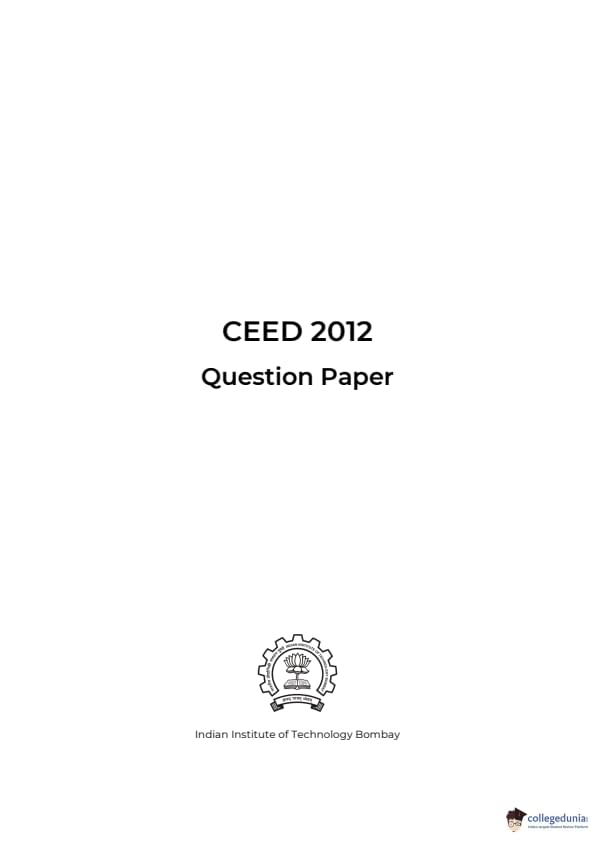
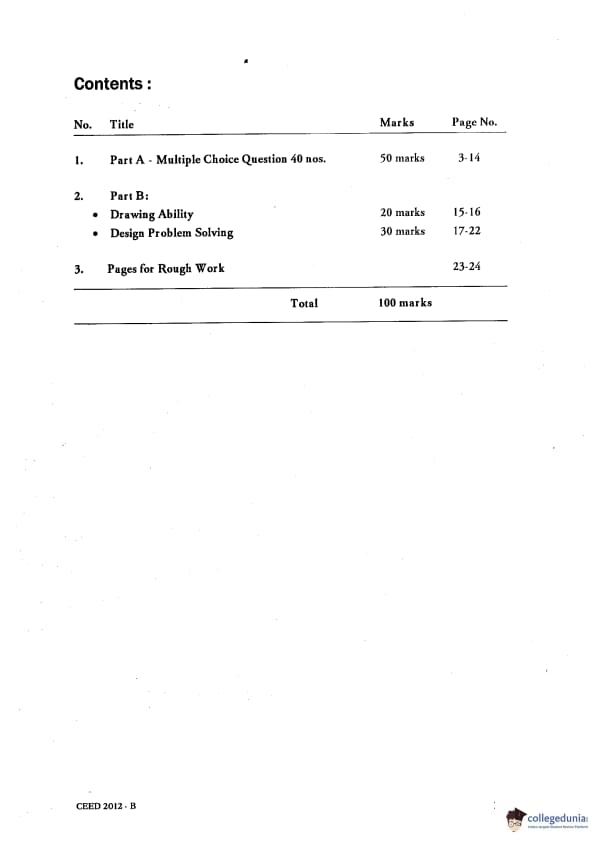
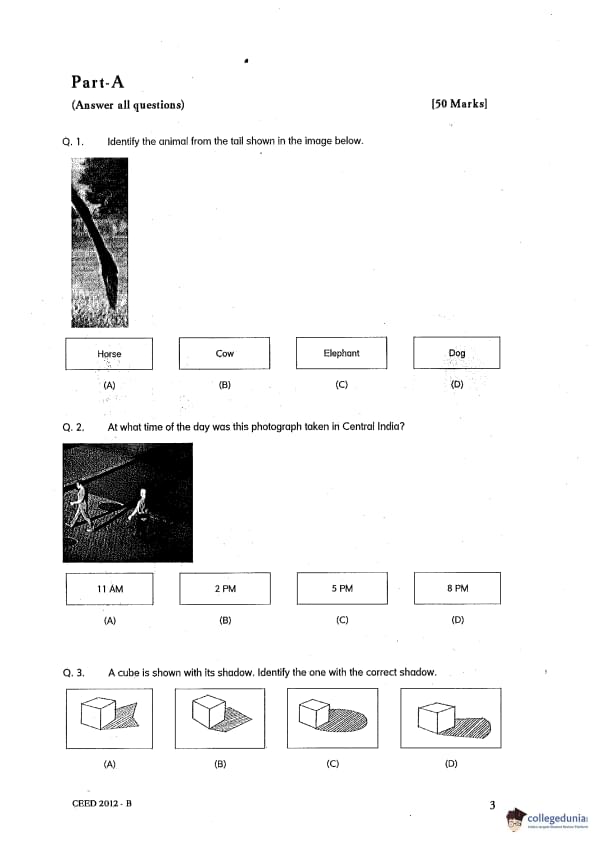

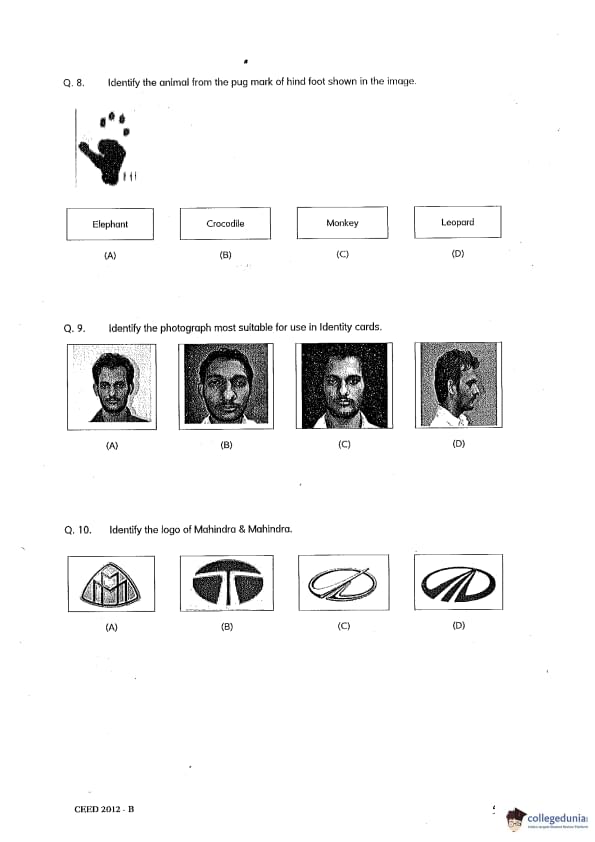
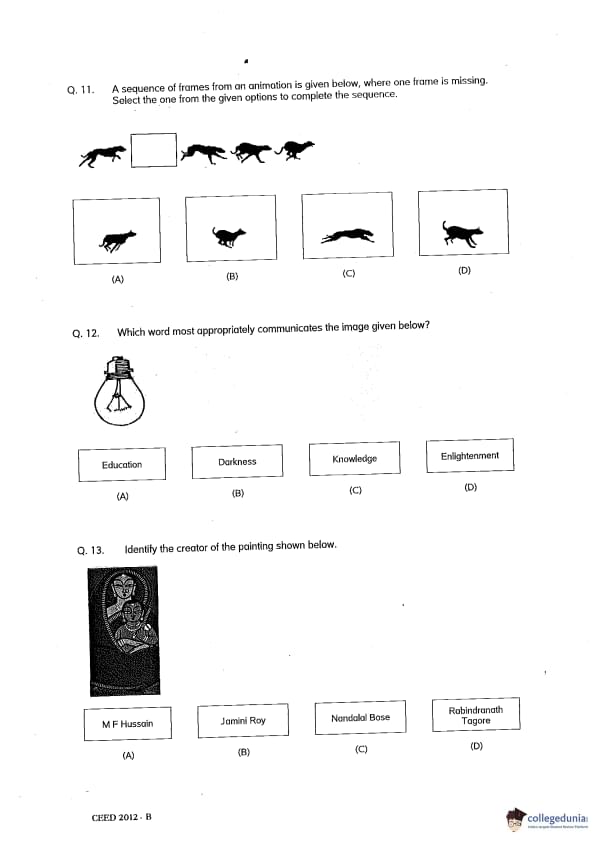
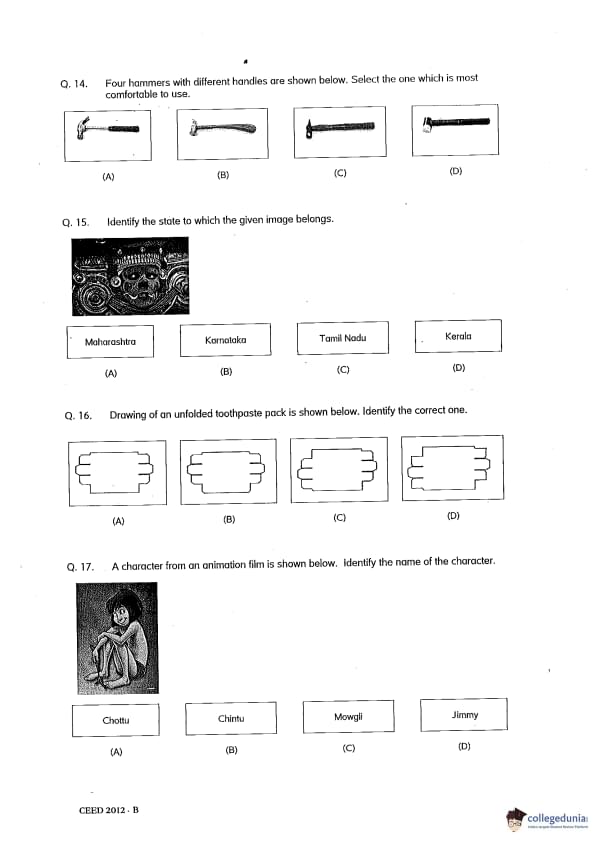
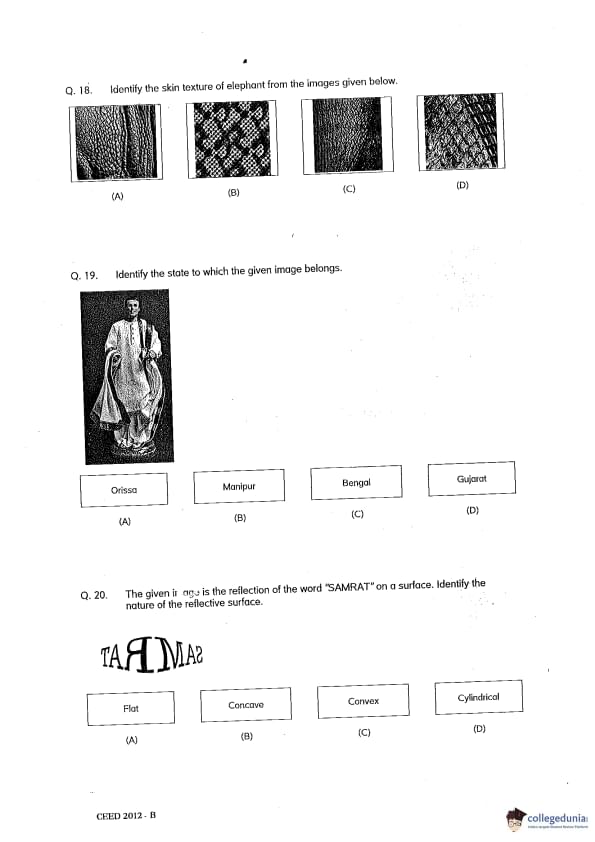
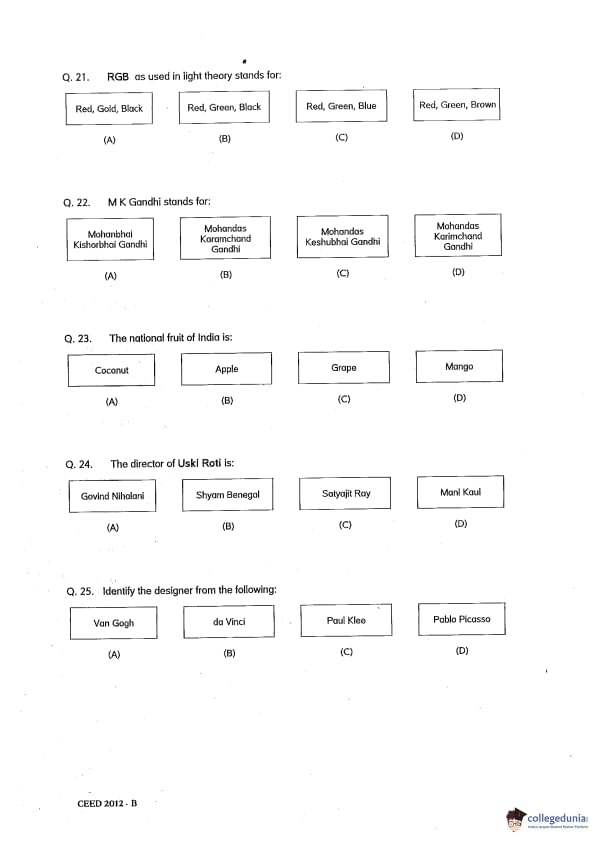
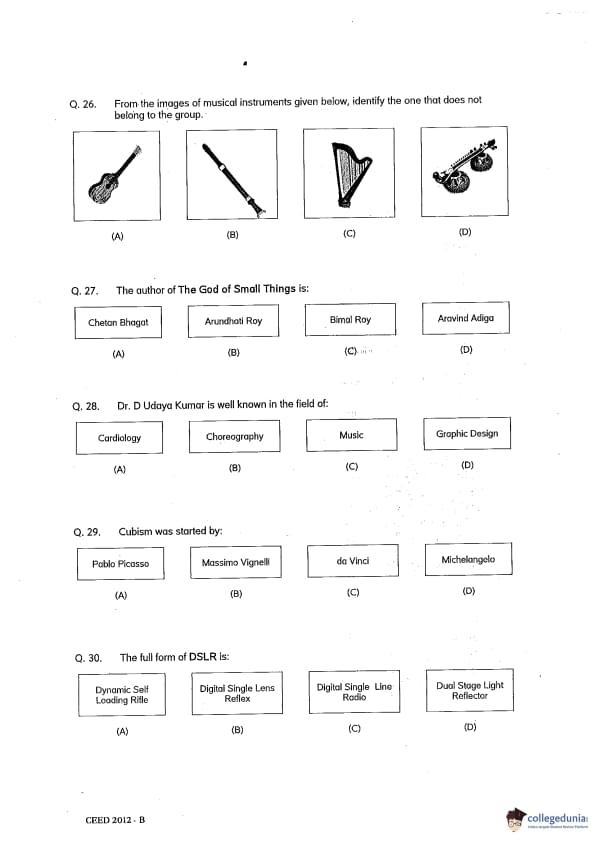
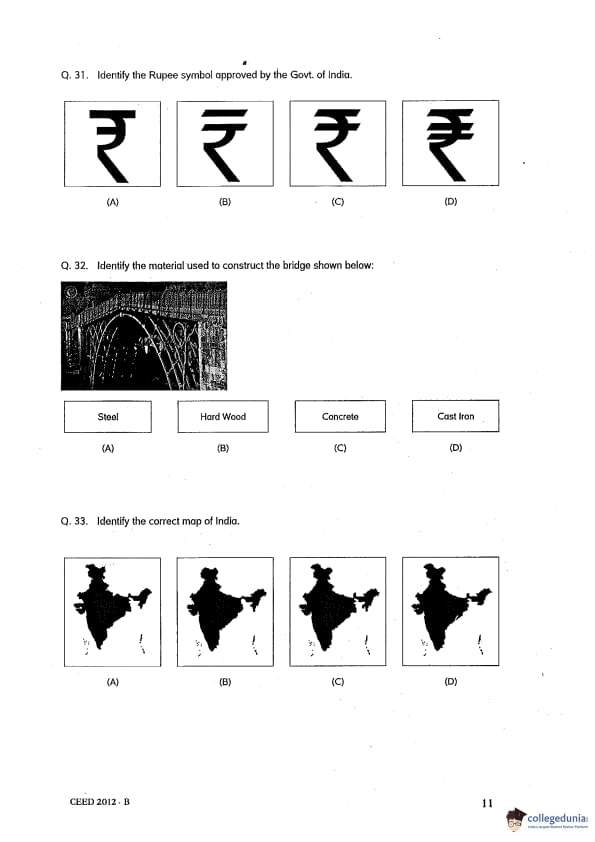
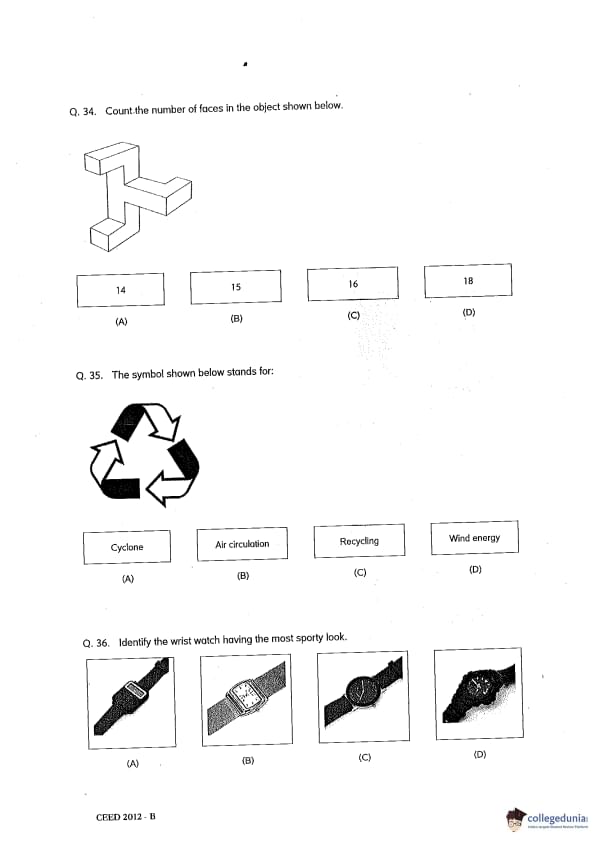
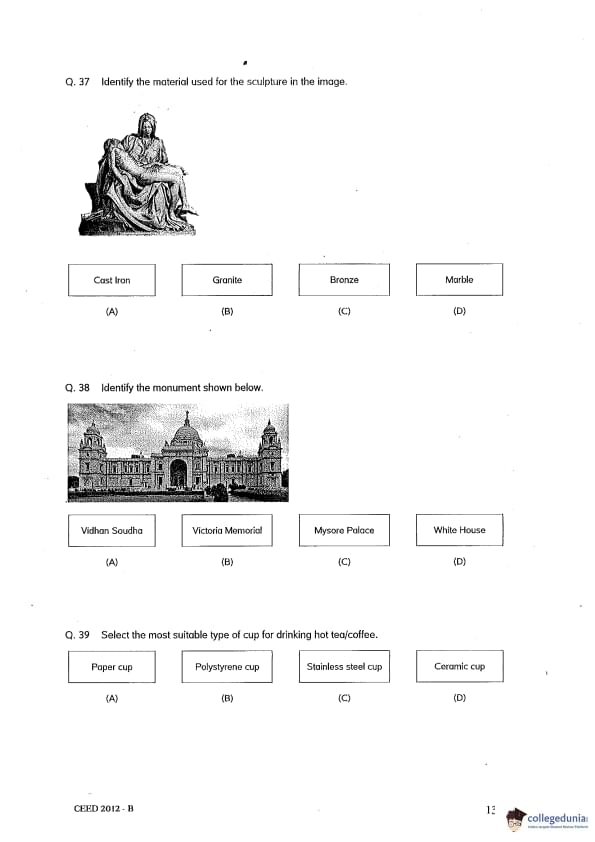
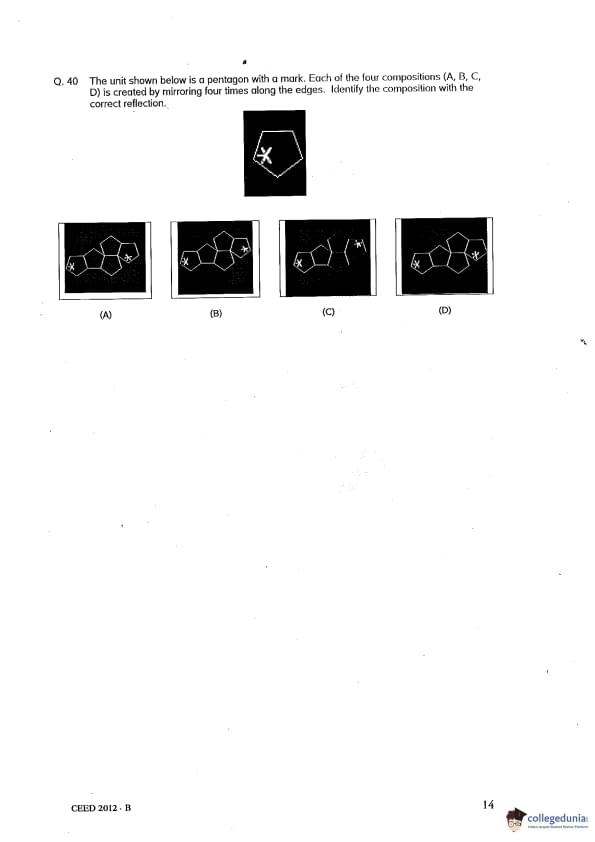
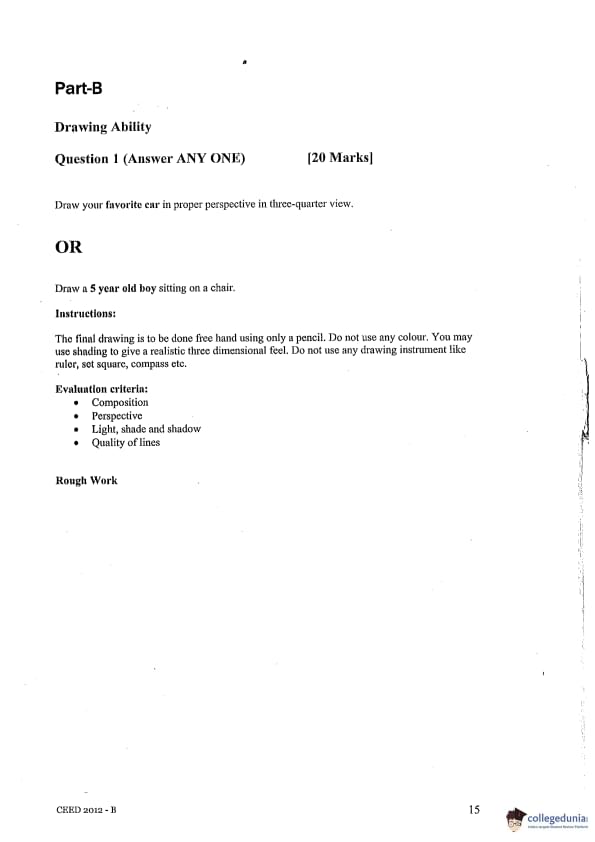
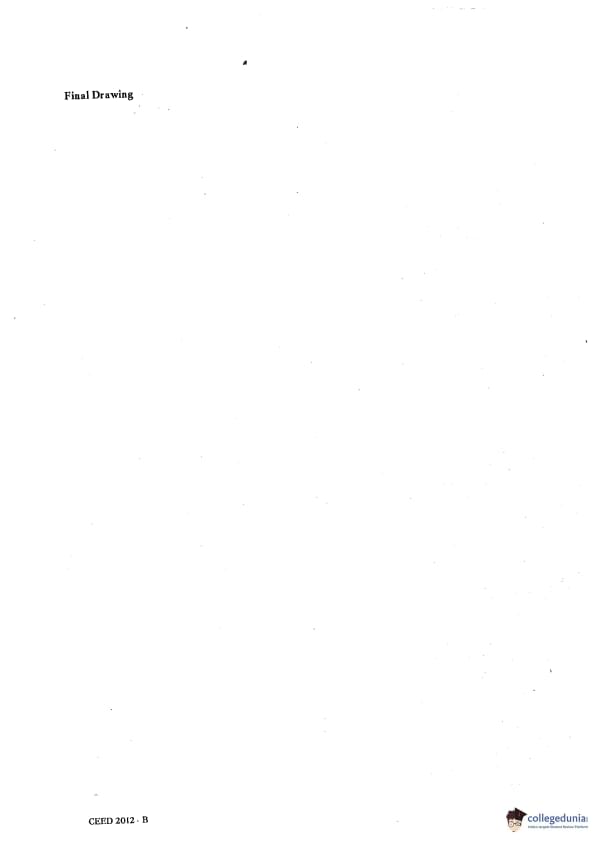

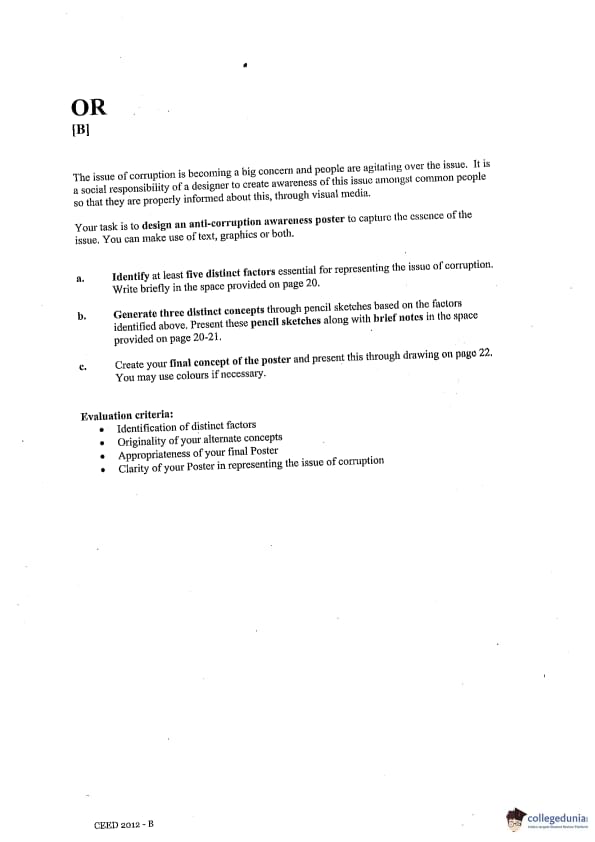

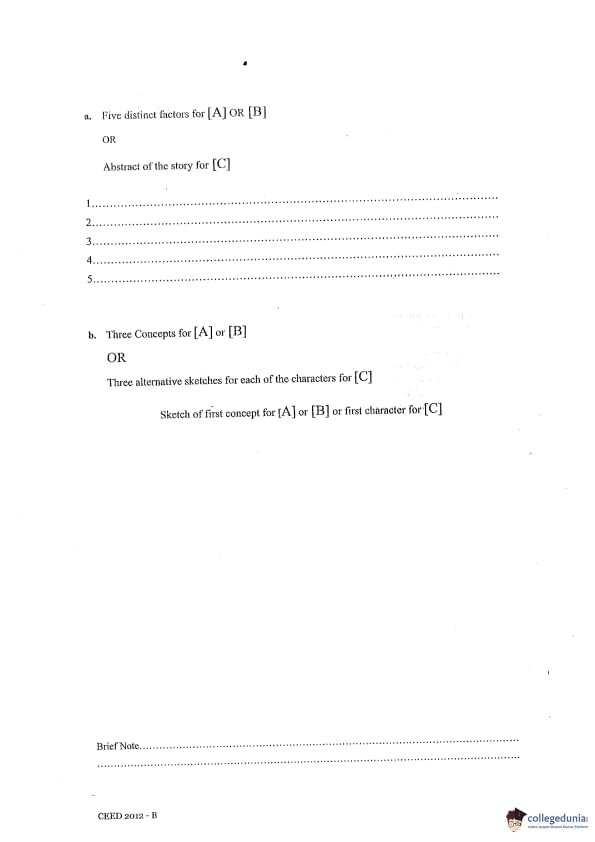
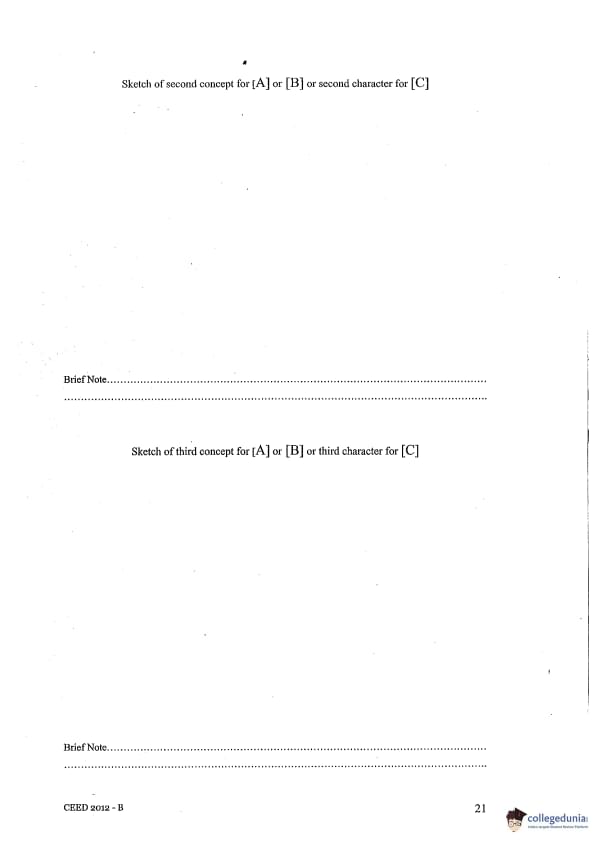
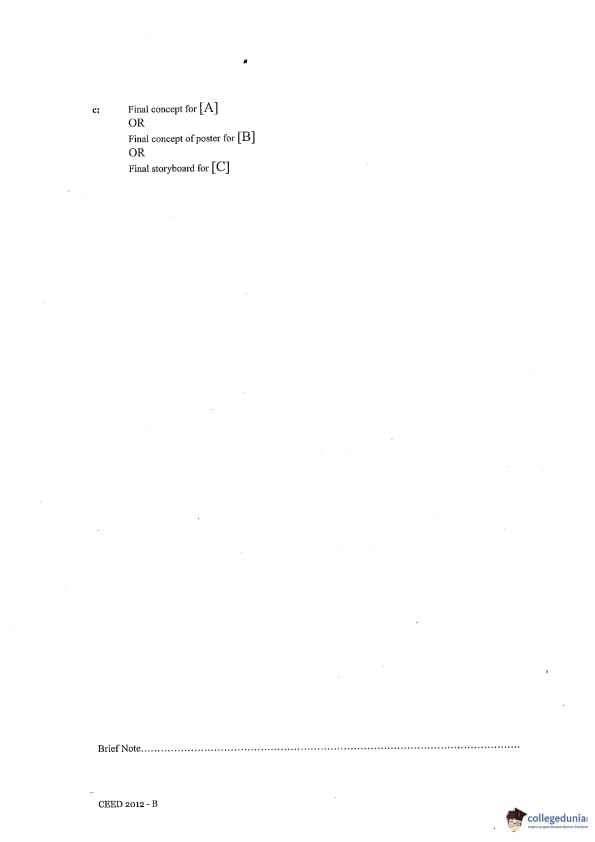

























Comments